Abstract
The overall goals of the studies presented here were to compare (1) the accuracies of saccades to moving targets with either a novel or a known target motion, and (2) the relationships between the measures of target motion and saccadic amplitude during pursuit initiation and maintenance. Since resampling of position error just prior to saccade initiation can confound the interpretation of results, the target ramp was masked during the planning and execution of the saccade. The results suggest that saccades to moving targets were significantly more accurate if the target motion was known from the early part of the trial (e.g., during pursuit maintenance) than in the case of novel target motion (e.g., during pursuit initiation); both these types of saccades were more accuate than those when target motion information was not available. Using target velocity in space as a rough estimate of the magnitude of the extra-retinal signal during pursuit maintenance, the saccadic amplitude was significantly associated with the extra-retinal target motion information after accounting for the position error. In most subjects, this association was stronger than the one between retinal slip velocity and saccadic amplitude during pursuit initiation. The results were similar even when the smooth eye motion prior to the saccade was controlled. These results suggest that different sources of target motion information (retinal image velocity vs internal representation of previous target motion in space) are used in planning saccades during different stages of pursuit. The association between retinal slip velocity and saccadic amplitude is weak during initiation, thus explaining poor saccadic accuracy during this stage of pursuit.
Similar content being viewed by others
References
Barnes GR, Asselman PT (1991) The mechanism of prediction in human smooth pursuit eye movements. J Physiol (Lond) 439: 439–461
Barnes GR, Asselman PR (1992) Pursuit of intermittently illuminated moving targets in the human. J Physiol (Lond) 445: 617–637
van den Berg AV (1988) Human smooth pursuit during transient perturbations of predictable and unpredictable target movement. Exp Brain Res 72:95–108
Gellman RS, Carl JR (1991) Motion processing for saccadic eye movements in humans. Exp Brain Res 84:660–667
Heywood S, Churcher J (1980) Saccades to step-ramp stimuli. Vision Res 21:479–490
Dunn OJ, Clark V (1969) Correlation coefficients measured on the same individuals. J Am Stat Assoc 64:366–377
Keller E, Johnsen SD (1990) Velocity prediction in corrective saccades during smooth pursuit eye movements in monkey. Exp Brain Res 80:525–531
Lisberger SG, Morris EJ, Tychsen L (1987) Visual motion processing and sensory motor integration for smooth pursuit eye movements. Annu Rev Neurosci 10:97–129
Leigh JR, Zee DS (1991) The neurology of eye movements. FA Davis, Philadelphia
Newsome WT, Wurtz RH, Dursteler MR, Mikami A (1985) Deficits in visual motion processing following ibotenic acid lesions of the middle temporal visual area of the macaque monkey. J Neurosci 5:825–840
Rashbass C (1961) The relationship between saccadic and smooth tracking eye movements. J Physiol (Lond) 159:326–328
Robinson DA (1965) The mechanics of smooth pursuit eye movement. J Physiol (Lond) 180:569–591
Ron S, Vieville T, Droulez J (1989) Target velocity based prediction in saccadic vector programming. Vision Res 29:1103–1114
Thaker GK, Ross DE, Buchanan RW, Moran MJ, Lahti A, Kim CE, Medoff D (1996) Does pursuit abnormality in schizophrenia represent a deficit in the predictive mechanism? Psychiatry Res (in press)
Author information
Authors and Affiliations
Rights and permissions
About this article
Cite this article
Kim, C.E., Thaker, G.K., Ross, D.E. et al. Accuracies of saccades to moving targets during pursuit initiation and maintenance. Exp Brain Res 113, 371–377 (1997). https://doi.org/10.1007/BF02450336
Received:
Accepted:
Issue Date:
DOI: https://doi.org/10.1007/BF02450336




